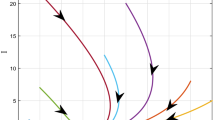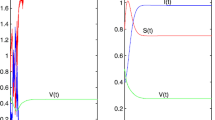Abstract
In this paper, we consider a numerical threshold for a coupled age-structured SIS epidemic model. We deal with the existence, convergence and stability of a linearly implicit Euler method for an age-independent SIS model firstly. It is shown that the numerical processes replicate the global dynamical behaviors of SIS model for any time-step size. We continue analyzing an age-structured SIS model similarly by introducing the numerical total population \(p_{j}^{n}\) to overcome the coupling. With the help of Krein–Rutman’s theorem, the numerical basic reproduction numbers \(R_{\Delta t}^{1}\) and \(R_{\Delta t}^{2}\) are presented, which play a decisive role in the numerical dynamical behavior of disease-free equilibrium and endemic equilibrium. Moreover, instead of the convergence of numerical solutions, it is much more interesting that the numerical basic reproduction numbers converge to the exact ones with accuracy of order 1. Finally, numerical applications to SIS epidemic models illustrate the verification and the efficiency of our results.






Similar content being viewed by others
References
Kermack, W.O., McKendrick, A.G.: Contributions to the mathematical theory of epidemics-I. 1927. Bull. Math. Biol. 53(1–2), 33–55 (1991)
Kermack, W.O., McKendrick, A.G.: Contributions to the mathematical theory of epidemics. II—The problem of endemicity. Bull. Math. Biol. 138(834), 55–83 (1932)
Otunuga, O.M.: Time-dependent probability distribution for number of infection in a stochastic SIS model: case study COVID-19. Chaos Solitons Fractals 147, 110983 (2021)
Iannelli, M., Milner, F.A., Pugliese, A.: Analytical and numerical results for the age-structured SIS epidemic model with mixed inter-intracohort transmission. SIAM J. Math. Anal. 23(3), 662–688 (1992)
Busenberg, S.N., Iannelli, M., Thieme, H.R.: Global behavior of an age-structured epidemic model. SIAM J. Math. Anal. 22(4), 1065–1080 (1991)
Busenberg, S.N., Iannelli, M., Thieme, H.R., et al.: Dynamics of an age structured epidemic model. Dyn. Syst. Nankai Ser. Pure Appl. Math. Theor. Phys. 4, 1–19 (1993)
Ainseba, B., Bouguima, S., Fekih, S.: Biological consistency of an epidemic model with both vertical and horizontal transmissions. Nonlinear Anal. Real World Appl. 28, 192–207 (2016)
Kang, H., Ruan, S.: Mathematical analysis on an age-structured SIS epidemic model with nonlocal diffusion. J. Math. Biol. 83(1), 5 (2021)
Alexanderian, A., Gobbert, M.K., Fister, K.R., Gaff, H., Lenhart, S., Schaefer, E.: An age-structured model for the spread of epidemic cholera: analysis and simulation. Nonlinear Anal. Real World Appl. 12(6), 3483–3498 (2011)
McCluskey, C.C.: Global stability for an SEI epidemiological model with continuous age-structure in the exposed and infectious classes. Math. Biosci. Eng. 9(4), 819–841 (2012)
Akimenko, V.V.: Asymptotically stable states of nonlinear age-structured monocyclic population model I. Travelling wave solution. Math. Comput. Simul. 133, 2–23 (2017)
Akimenko, V.V.: Asymptotically stable states of non-linear age-structured monocyclic population model II. Numerical simulation. Math. Comput. Simul. 133, 24–38 (2017)
Akimenko, V.V.: Nonlinear age-structured models of polycyclic population dynamics with death rates as power functions with exponent \(n\). Math. Comput. Simul. 133, 175–205 (2017)
Akimenko, V.V.: An age-structured SIR epidemic model with fixed incubation period of infection. Comput. Math. Appl. 73(7), 1485–1504 (2017)
Kuniya, T.: Numerical approximation of the basic reproduction number for a class of age-structured epidemic models. Appl. Math. Lett. 73, 106–112 (2017)
Bacaër, N.: Approximation of the basic reproduction number \({R}_0\) for vector-borne diseases with a periodic vector population. Bull. Math. Biol. 69, 1067–1091 (2007)
Yang, H.Z., Yang, Z.W., Liu, S.Q.: Numerical threshold of linearly implicit Euler method for nonlinear infection-age SIR models. Discrete Cont. Dyn. B 28(1), 70–92 (2023)
Ganegoda, N., Götz, T., Wijaya, K.P.: An age-dependent model for dengue transmission: analysis and comparison to field data. Appl. Math. Comput. 388, 125538 (2021)
Singh, A., Deolia, P.: COVID-19 outbreak: a predictive mathematical study incorporating shedding effect. J. Appl. Math. Comput. 69(1), 1239–1268 (2023)
Reyné, B., Richard, Q., Selinger, C., Sofonea, M.T., Djidjou-Demasse, R., Alizon, S.: Non-markovian modelling highlights the importance of age structure on Covid-19 epidemiological dynamics. Math. Modell. Nat. Phenom. 17, 7 (2022)
Bera, S., Khajanchi, S., Roy, T.K.: Stability analysis of fuzzy HTLV-I infection model: a dynamic approach. J. Appl. Math. Comput. 69(1), 171–199 (2023)
Bera, S., Khajanchi, S., Roy, T.K.: Dynamics of an HTLV-I infection model with delayed CTLs immune response. Appl. Math. Comput. 430, 127206 (2022)
Mondal, J., Khajanchi, I., Akhtar, M.N.: A mathematical model for COVID-19 pandemic with the impact of economic development. In: Fractal Signatures in the Dynamics of an Epidemiology, pp. 118–134. CRC Press
Tiwari, P.K., Rai, R.K., Khajanchi, S., Gupta, R.K., Misra, A.K.: Dynamics of coronavirus pandemic: effects of community awareness and global information campaigns. Eur. Phys. J. Plus. 136(10), 994 (2021)
Hattaf, K., Yousfi, N.: A numerical method for delayed partial differential equations describing infectious diseases. Comput. Math. Appl. 72(11), 2741–2750 (2016)
Hattaf, K., Lashari, A.A., El Boukari, B., Yousfi, N.: Effect of discretization on dynamical behavior in an epidemiological model. Differ. Equ. Dyn. Syst. 23, 403–413 (2015)
Yang, Z.W., Zuo, T.Q., Chen, Z.J.: Numerical analysis of linearly implicit Euler–Riemann method for nonlinear Gurtin–MacCamy model. Appl. Numer. Math. 163, 147–166 (2021)
Chen, Z.J., Xu, R.Z., Yang, Z.W.: Numerical analysis of linear \(\theta \)-methods with two-layer boundary conditions for age-structured population models. Math. Comput. Simul. 182, 603–619 (2021)
Yan, D.X., Fu, X.L.: Analysis of an age-structured HIV infection model with logistic target-cell growth and antiretroviral therapy. IMA J. Appl. Math. 83(6), 1037–1065 (2018)
Rihan, F., Arafa, A., Rakkiyappan, R., Rajivganthi, C., Xu, Y.: Fractional-order delay differential equations for the dynamics of hepatitis C virus infection with IFN-\(\alpha \) treatment. Alex. Eng. J. 60(5), 4761–4774 (2021)
Hattaf, K.: On the stability and numerical scheme of fractional differential equations with application to biology. Computation 10(6), 97 (2022)
Hattaf, K.: A new class of generalized fractal and fractal-fractional derivatives with non-singular kernels. Fractal Fractional 7(5), 395 (2023)
Funding
This paper is supported by Heilongjiang Provincial Natural Science Foundation of China (LH2022A006).
Author information
Authors and Affiliations
Corresponding author
Ethics declarations
Conflict of interest
The authors declare that they have no known competing financial interests or personal relationships that could have appeared to influence the work reported in this paper.
Additional information
Publisher's Note
Springer Nature remains neutral with regard to jurisdictional claims in published maps and institutional affiliations.
Rights and permissions
Springer Nature or its licensor (e.g. a society or other partner) holds exclusive rights to this article under a publishing agreement with the author(s) or other rightsholder(s); author self-archiving of the accepted manuscript version of this article is solely governed by the terms of such publishing agreement and applicable law.
About this article
Cite this article
Chen, Z., Yang, Z. & Sheng, D. Numerical analysis of linearly implicit Euler method for age-structured SIS model. J. Appl. Math. Comput. 70, 969–996 (2024). https://doi.org/10.1007/s12190-024-01986-9
Received:
Revised:
Accepted:
Published:
Issue Date:
DOI: https://doi.org/10.1007/s12190-024-01986-9




